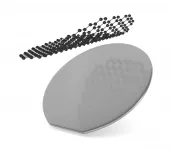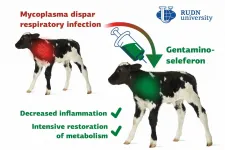Rapid ice retreat during last deglaciation parallels current melt rates
2021-02-10
(Press-News.org) 10,000 km2 of ice disappeared in a blink of an eye from an ice sheet in the Storfjorden Through offshore Svalbard, a new study shows. This dramatic break off was preceded by quite a rapid melt of 2.5 kilometres of ice a year. This parallels the current melt rates in Antarctica and Greenland and worries the scientists behind the study.
"Our measurements of the ice retreat in Storfjorden Through show that the prevailing conditions to the great break off, match what we see in Antarctica and Greenland today. It is uncanny. There are new studies published almost weekly, that show that the retreat of current ice sheets is two to four km a year and that it's speeding up." Says CAGE-professor and first author Tine Lander Rasmussen.
Climatically unstable period
The last deglaciation, 20,000- 10,000 years ago, was a period of coexisting global warming and rapidly shrinking ice sheets. But stating the actual correlation between the two is not as simple as it sounds. The period in question was climatically unstable, and big melts were interrupted by re-freezing and formation of new ice. The speed of the ice retreat, relative to climatic changes, has therefore been difficult to establish.
"We have studied the ice sheet development 20 000 - 10 000 years ago using marine sediment cores. The 12 cores have been collected in the area during the past 18 years, and meticulously analysed for different types of microfossils of single-celled organisms called foraminifera," says Rasmussen.
The biochemistry in the foraminifera fossils helps reconstruct the enormous amount of information about the state of the environment in prehistoric times. The sediments were sliced up in slices representing time periods of 30 to 70 years. Over 70 samples were dated and analyzed.
"What we saw is that the ice sheet starts retreating some 20,000 years ago but lingers on a ridge in the fjord. Then, some 15,000 years ago the atmosphere and ocean temperatures warm up, impacting the ocean circulation. A huge chunk of the ice sheet disappears at the same time. At the start of the Holocene warm period, 11,000 years ago, things really pick up speed. We can't see any more evidence of an ice sheet covering the ocean floor after that time."
Consistent correlation between global warming and ice retreat
The periods of extremely rapid ice sheet retreats are consistently correlating with periods of global warming of oceans and temperature. This is mirrored in ice sheet retreat from other eight Northern Norwegian fjord systems.
"This is strengthening our hypothesis that an increase in ocean temperature and global warming is the direct cause of the chain of the events leading up to the dramatically rapid ice sheet disintegration." Says Rasmussen.
This gives some alarming perspectives on present-day outlook. The great melt of the glacial maximum to the Holocene was 10,000 years in the making. The present climate change is much more rapid.
"The final retreat of the Storfjorden Through ice sheet happened as rapidly in the outer parts as it did further up the through. This means that as soon as warmer oceanic water got access to the ice sheet, it surged pretty rapidly inward from the edge of the ice shelf. To the interior of the sheet itself. We see this happening in Antarctica today. The Larsen A (1995), B (2003) and C (2017) break-offs are examples of this process. "
INFORMATION:
[Attachments] See images for this press release:

ELSE PRESS RELEASES FROM THIS DATE:
2021-02-10
Two-dimensional (2D) materials have a huge potential for providing devices with much smaller size and extended functionalities with respect to what can be achieved with today's silicon technologies. But to exploit this potential we must be able to integrate 2D materials into semiconductor manufacturing lines - a notoriously difficult step. A team of Graphene Flagship researchers in Sweden and Germany now reports a new method to make this work.
The technique, just published in Nature Communications by researchers from Graphene Flagship partners RWTH Aachen University, Universität der Bundeswehr ...
2021-02-10
New research from Trinity College Dublin suggests that older adults can be more focused, less impeded by anxiety and less mentally restless than younger adults. The team at the Trinity College Institute of Neuroscience (TCIN) (today, Wednesday, 10th February, 2021) show that older adults appear to mitigate the negative aspects of cognitive decline by increasing motivation and adopting more efficient strategies to suspend the wandering mind when focus is required.
The study, published in the journal Psychology and Aging (American Psychological Association) is the first to adjudicate between competing theories of age-related ...
2021-02-10
In recent years, three meta-analyses of clinical studies have come to the conclusion that vitamin D supplementation was associated with a reduction in the mortality rate from cancer of around 13 percent. Scientists at the German Cancer Research Center (DKFZ) have now transferred these results to the situation in Germany and calculated: If all Germans over the age of 50 were to take vitamin D supplements, up to 30,000 cancer deaths per year could possibly be avoided and more than 300,000 years of life could be gained - in addition, health care costs could be saved.
For several years now, scientists have been investigating the influence of an adequate supply of vitamin D on the ...
2021-02-10
Overfishing, hunting and intensive agriculture and forestry can sometimes contribute to plants and animals becoming endangered. New research from Lund University in Sweden and University of Toronto can now show why this leads to entire populations becoming smaller in size, as well as reproducing earlier. The study is published in the journal PNAS.
Researchers from Lund and Toronto are behind the study conducted on five different species of damselflies. They have studied how different environmental factors affect when and at what size the damselflies begin to reproduce. In the study, the researchers also shed light on how overfishing off the coast ...
2021-02-10
COLUMBUS, Ohio - The death of a vampire bat 19 days after giving birth presented scientists studying the animals in 2019 with an unexpected chance to observe a rare event: a female bat's adoption of an unrelated baby.
The researchers had captured common vampire bats in Panama as part of ongoing studies of the formation of cooperative relationships among strangers. The team used infrared surveillance cameras to observe six hours of vampire bat activity spaced over the span of each day.
Two unrelated and unfamiliar female bats were observed forming a social bond based on mutual grooming and food sharing that increased over time. The researchers had named them BD and Lilith.
Lilith ...
2021-02-10
Respiratory tract diseases in young animals of the cattle are a big issue for world agriculture and food safety because a bacterium that causes them is resistant to most antibiotics. A team of veterinarians from RUDN University developed and tested a complex preparation called gentaminoseleferon that could help treat respiratory infection in calves. The results of the study were published in the Veterinary World journal.
Bacteria of the genus Mycoplasma cause many infectious diseases in animals, including atypical pneumonia, other respiratory tract conditions, reproductive pathologies, arthritis, keratoconjunctivitis, mastitis, and so on. The genus includes about 200 species of bacteria, and all of them ...
2021-02-10
Every day, people die from simple infections even though they have been treated with antibiotics. This is because more and more bacteria have become resistant to the types of antibiotics that doctors can prescribe.
- It's a huge societal problem and a crisis that we must solve. For example, by developing new antibiotics that can defeat the resistant bacteria, says professor of chemistry at the Department of Physics, Chemistry and Pharmacy, University of Southern Denmark, Poul Nielsen.
Resistant bacteria are not only known from pig farms, where it is becoming increasingly difficult to keep the pigsties disease-free. Hospitals are also experiencing with increasing regularity that, for example, infectious diseases cannot be controlled in patients. Thus, ...
2021-02-10
Can long-term stress lead to heart attacks? Most people would probably answer in the affirmative, but the scientific evidence of this is scarce. A new study by researchers from Linköping University in Sweden reveals that the levels of the stress hormone cortisol were increased in the months preceding a heart attack. The results, published in Scientific Reports, suggest that long-term stress is a risk factor for heart attacks.
"The levels of the stress hormone cortisol differed between people who have had a heart attack and those not affected. This suggests that cortisol in hair may be a new risk marker for heart attacks. We must take stress seriously", says Professor Tomas Faresjö from the Department of Health, ...
2021-02-10
Ruptured abdominal aortic aneurysms (rAAA) are responsible for nearly 2% of all deaths in U.S. men over the age of 65. Endovascular aneurysm repair (EVAR) has emerged as a newer and less invasive alternative to open repair for rAAA, and current guidelines recommend EVAR as a first-line option for treatment of rAAA when certain criteria are met. But researchers from the University of Missouri School of Medicine have discovered that while EVAR is more commonly utilized for rAA, shortens hospital stay and has a lower initial mortality rate, the odds of ...
2021-02-10
Researchers at the RIKEN Center for Biosystems Dynamics Research in Japan have discovered a recipe for continuous cyclical regeneration of cultured hair follicles from hair follicle stem cells.
Scientists have been making waves in recent years by developing ways to grow a variety of useful items in laboratories, from meat and diamonds to retinas and other organoids. At the RIKEN Center for Biosystems Dynamics Research in Japan, a team led by Takashi Tsuji has been working on ways to regenerate lost hair from stem cells. In an important step, a new study identifies a population of hair follicle stem cells in the skin and a recipe for normal cyclical regeneration in the lab.
The researchers took fur and whisker cells ...
LAST 30 PRESS RELEASES:
[Press-News.org] Rapid ice retreat during last deglaciation parallels current melt rates





